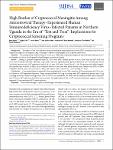| dc.contributor.author | Okwir, Mark | |
| dc.contributor.author | Link, Abigail | |
| dc.contributor.author | Rhein, Joshua | |
| dc.contributor.author | Obbo, John Stephen | |
| dc.contributor.author | Okello, James | |
| dc.contributor.author | Nabongo, Betty | |
| dc.contributor.author | Alal, Jimmy | |
| dc.contributor.author | Meya, David | |
| dc.contributor.author | Bohjanen, Paul R. | |
| dc.date.accessioned | 2023-07-17T11:28:25Z | |
| dc.date.available | 2023-07-17T11:28:25Z | |
| dc.date.issued | 2022 | |
| dc.identifier.citation | Okwir, M., Link, A., Rhein, J., Obbo, J. S., Okello, J., Nabongo, B., ... & Bohjanen, P. R. (2022, February). High burden of cryptococcal meningitis among antiretroviral therapy–experienced human immunodeficiency virus–infected patients in Northern Uganda in the era of “test and treat”: implications for cryptococcal screening programs. In Open forum infectious diseases (Vol. 9, No. 2, p. ofac004). US: Oxford University Press. | en_US |
| dc.identifier.uri | https://creativecommons.org/ licenses/by-nc-nd/4.0/) | |
| dc.identifier.uri | http://ir.lirauni.ac.ug/xmlui/handle/123456789/731 | |
| dc.description.abstract | Background. The impact of the “test and treat” program for human immunodeficiency virus (HIV) treatment in rural areas of
Uganda on cryptococcal antigen (CrAg) screening or cryptococcal meningitis (CM) is poorly understood.
Methods. We retrospectively evaluated clinical factors in 212 HIV-infected patients diagnosed with CM from February of 2017
to November of 2019 at Lira Regional Referral Hospital in northern Uganda.
Results. Among 212 patients diagnosed with CM, 58.5% were male. Median age was 35 years; CD4 count and HIV viral load
(VL) were 86 cells/μL and 9463 copies/mL, respectively. Only 10% of patients had a previous history of CM. We found that 190 of
209 (90.9%) patients were ART experienced and 19 (9.1%) were ART naive. Overall, 90 of 212 (42.5%) patients died while hospital ized (median time to death, 14 days). Increased risk of death was associated with altered mental status (hazard ratio [HR], 6.6 [95%
confidence interval {CI}, 2.411–18.219]; P ≤ .0001) and seizures (HR, 5.23 [95% CI, 1.245–21.991]; P = .024).
Conclusions. Current guidelines recommend CrAg screening based on low CD4 counts for ART-naive patients and VL or clin ical failure for ART-experienced patients. Using current guidelines for CrAg screening, some ART-experienced patients miss CrAg
screening in resource-limited settings, when CD4 or VL tests are unavailable. We found that the majority of HIV-infected patients
with CM were ART experienced (90.9%) at presentation. The high burden of CM in ART-experienced patients supports a need for
improved CrAg screening of ART-exposed patients.
Keywords. antiretroviral therapy; cryptococcal meningitis outcomes; screening. | en_US |
| dc.language.iso | en | en_US |
| dc.publisher | Open forum infectious diseases | en_US |
| dc.subject | antiretroviral therapy | en_US |
| dc.subject | cryptococcal meningitis outcomes | en_US |
| dc.subject | screening | en_US |
| dc.title | High Burden of Cryptococcal Meningitis Among Antiretroviral Therapy–Experienced Human Immunodeficiency Virus–Infected Patients in Northern Uganda in the Era of “Test and Treat”: Implications for Cryptococcal Screening Programs | en_US |
| dc.type | Article | en_US |

